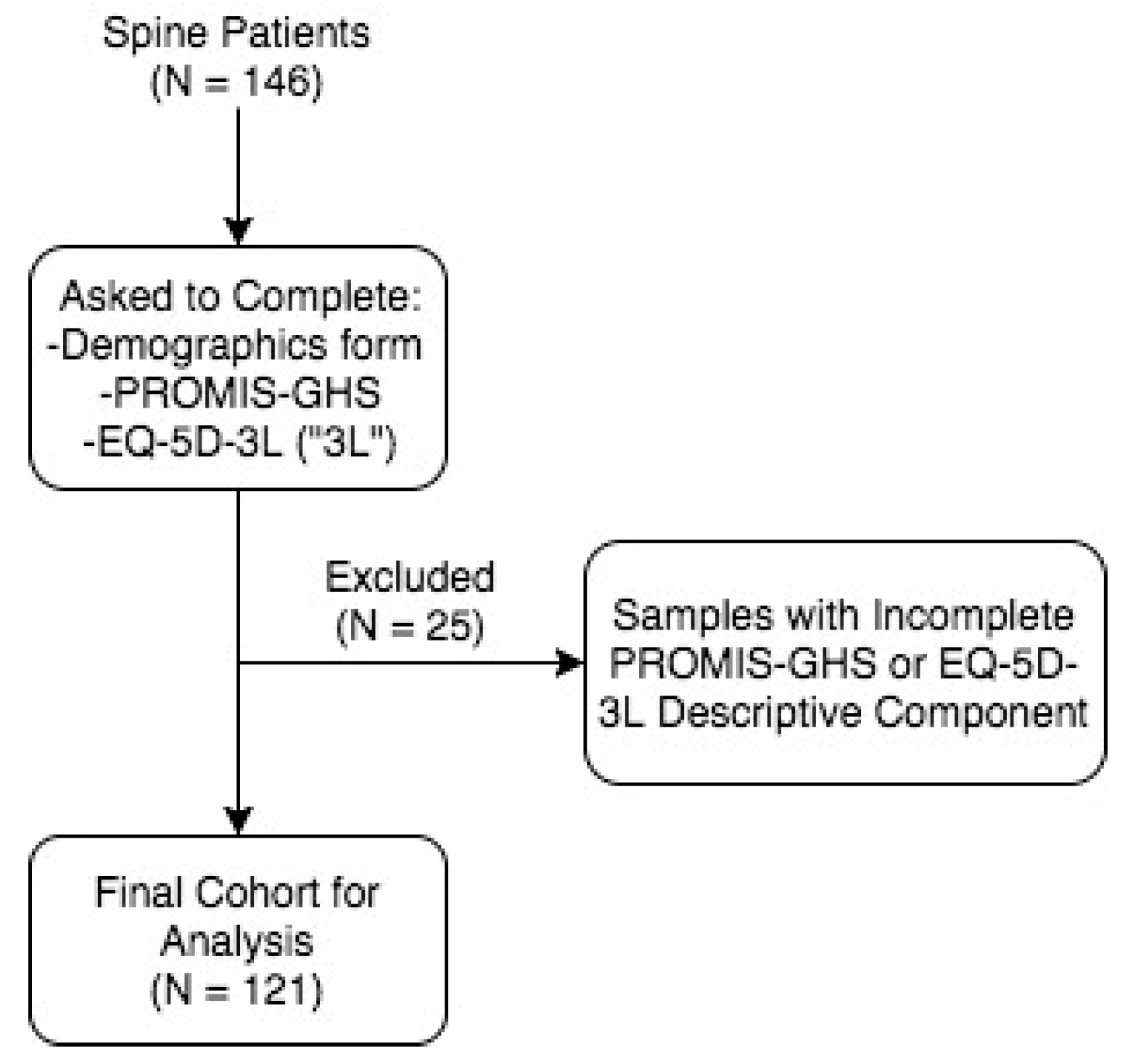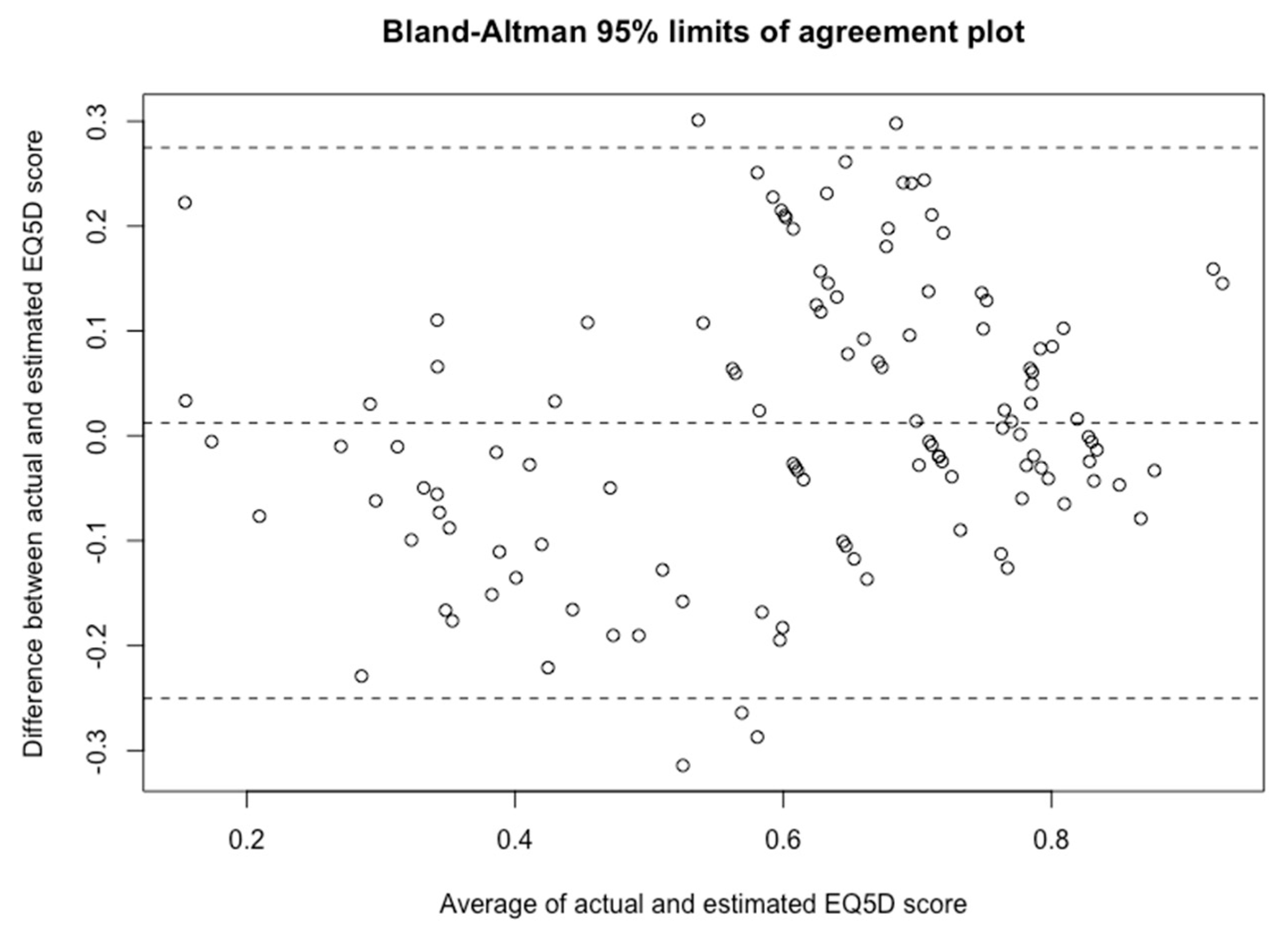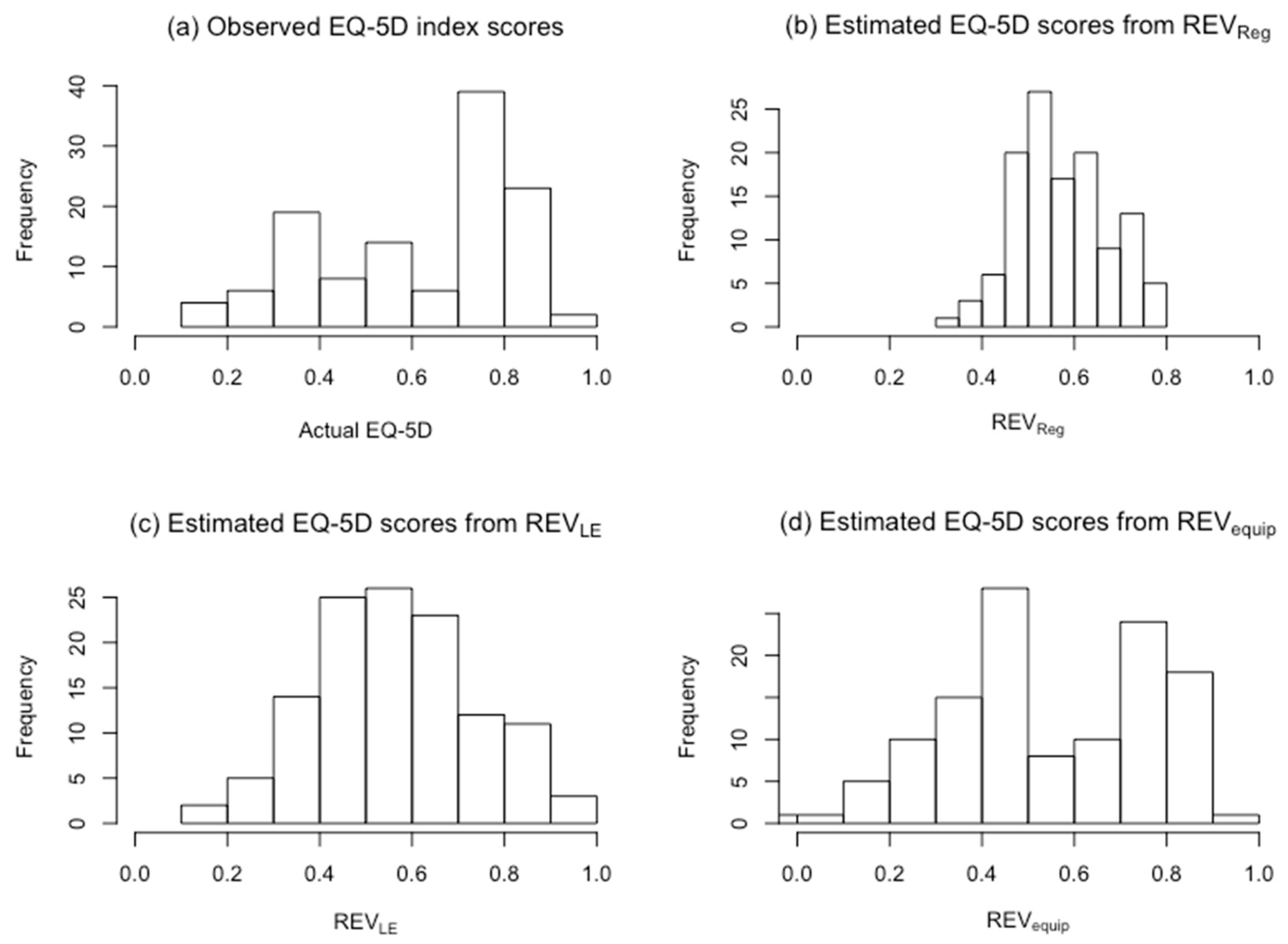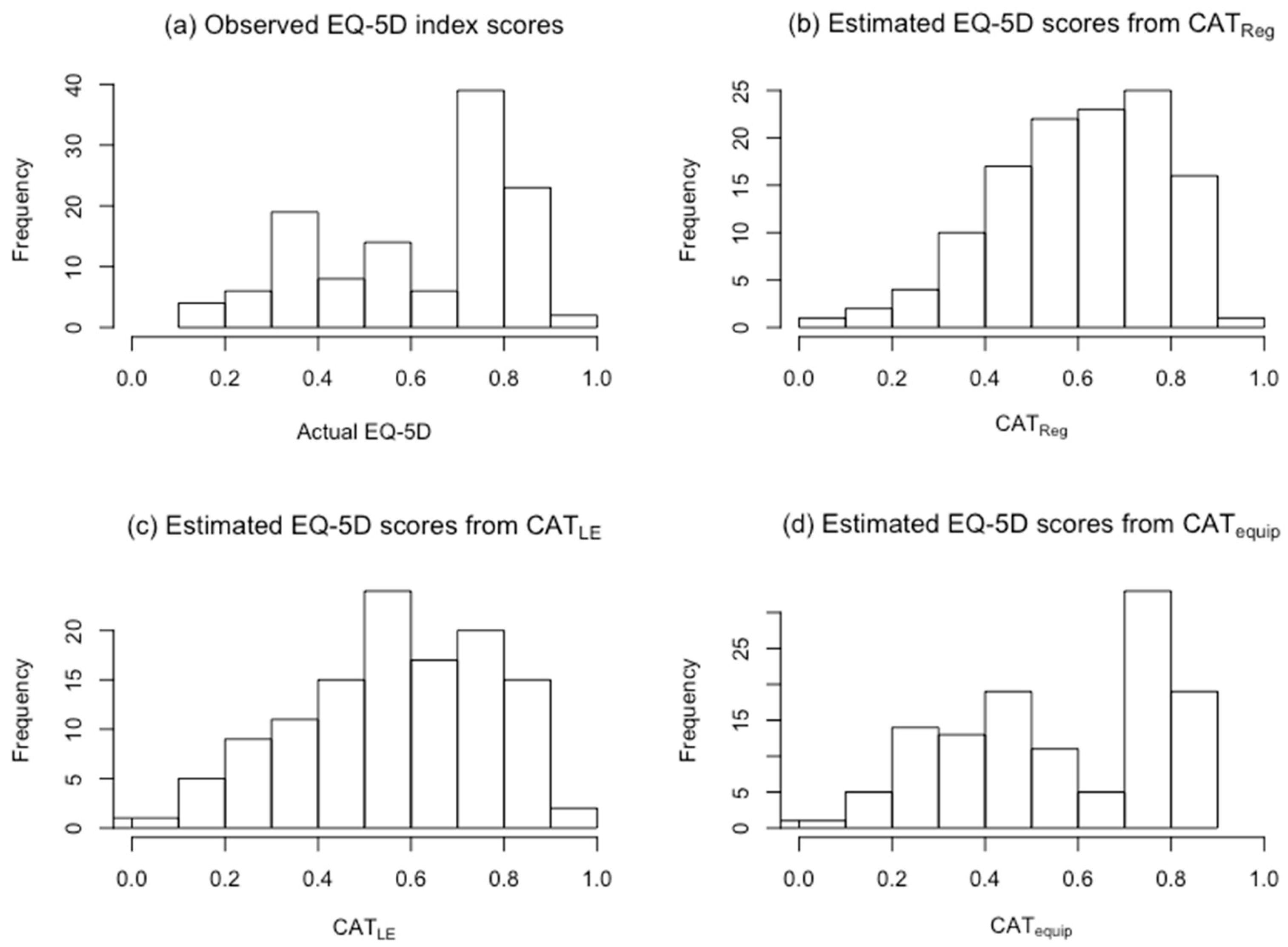Validating the Transformation of PROMIS-GH to EQ-5D in Adult Spine Patients
Abstract
1. Introduction
2. Experimental Section
2.1. Surveys
2.2. Study Design and Participants
2.3. Models Tested in the Study
2.4. Statistical Analysis
3. Results
3.1. Demographic Characteristics
3.2. Statistical Analysis
4. Discussion
4.1. Validation and Technical Aspects
4.2. Utility of Health Care Measurement
4.3. Clinical Implications
4.4. Limitations
5. Conclusions
Author Contributions
Conflicts of Interest
References
- Hoy, D.; March, L.; Brooks, P.; Blyth, F.; Woolf, A.; Bain, C.; Williams, G.; Smith, E.; Vos, T.; Barendregt, J.; et al. The global burden of low back pain: Estimates from the Global Burden of Disease 2010 study. Ann. Rheum. Dis. 2014, 73, 968–974. [Google Scholar] [CrossRef] [PubMed]
- Resnick, D.K.; Tosteson, A.N.; Groman, R.F.; Ghogawala, Z. Setting the equation: Establishing value in spine care. Spine 2014, 39, S43–S50. [Google Scholar] [CrossRef] [PubMed]
- Mroz, T.E.; McGirt, M.; Chapman, J.R.; Anderson, G.; Fehlings, M. More “why” and less “how”: Is value-based spine care the next breakthrough? Spine 2014, 39, S7–S8. [Google Scholar] [CrossRef] [PubMed]
- Cella, D.; Yount, S.; Rothrock, N.; Gershon, R.; Cook, K.; Reeve, B.; Ader, D.; Fries, J.F.; Bruce, B.; Rose, M. The Patient-Reported Outcomes Measurement Information System (PROMIS): Progress of an NIH roadmap cooperative group during its first two years. Med. Care 2007, 45, S3–S11. [Google Scholar] [CrossRef]
- Brooks, R.; Rabin, R.; De Charro, F. (Eds.) The Measurement and Valuation of Health Status Using EQ-5D: A European Perspective; Springer Science & Business Media: Berlin, Germany, 2013. [Google Scholar]
- Angevine, P.D.; Berven, S. Health economic studies: An introduction to cost-benefit, cost-effectiveness, and cost-utility analyses. Spine 2014, 39, S9–S15. [Google Scholar] [CrossRef]
- Dakin, H. Review of studies mapping from quality of life or clinical measures to EQ-5D: An online database. Health Qual. Life Outcomes 2013, 11, 151. [Google Scholar] [CrossRef] [PubMed]
- Sauerland, S.; Weiner, S.; Dolezalova, K.; Angrisani, L.; Noguera, C.M.; Garcia-Caballero, M.; Rupprecht, F.; Immenroth, M. Mapping utility scores from a disease-specific quality-of-life measure in bariatric surgery patients. Value Health 2009, 12, 364–370. [Google Scholar] [CrossRef][Green Version]
- Revicki, D.A.; Kawata, A.K.; Harnam, N.; Chen, W.H.; Hays, R.D.; Cella, D. Predicting EuroQol (EQ-5D) scores from the patient-reported outcomes measurement information system (PROMIS) global items and domain item banks in a United States sample. Qual. Life Res. 2009, 18, 783–791. [Google Scholar] [CrossRef]
- Forsyth, A.L.; Witkop, M.; Lambing, A.; Garrido, C.; Dunn, S.; Cooper, D.L.; Nugent, D.J. Associations of quality of life, pain, and self-reported arthritis with age, employment, bleed rate, and utilization of hemophilia treatment center and health care provider services: Results in adults with hemophilia in the HERO study. Patient Prefer. Adherence 2015, 9, 1549–1560. [Google Scholar] [CrossRef]
- Grosse, S.D.; Prosser, L.A.; Asakawa, K.; Feeny, D. QALY weights for neurosensory impairments in pediatric economic evaluations: Case studies and a critique. Expert Rev. Pharmacoecon. Outcomes Res. 2010, 10, 293–308. [Google Scholar] [CrossRef]
- Hung, W.W.; Ross, J.S.; Farber, J.; Siu, A.L. Evaluation of the mobile acute care of the elderly (MACE) service. JAMA Intern. Med. 2013, 173, 990–996. [Google Scholar] [CrossRef] [PubMed]
- Thompson, N.R.; Lapin, B.R.; Katzan, I.L. Mapping PROMIS Global Health Items to EuroQol (EQ-5D) Utility Scores Using Linear and Equipercentile Equating. PharmacoEconomics 2017, 35, 1167–1176. [Google Scholar] [CrossRef] [PubMed]
- EuroQol Group. EuroQol—A new facility for the measurement of health-related quality of life. Health Policy 1990, 16, 199–208. [Google Scholar] [CrossRef]
- Shaw, J.W.; Johnson, J.A.; Coons, S.J. US valuation of the EQ-5D health states: Development and testing of the D1 valuation model. Med. Care 2005, 43, 203–220. [Google Scholar] [CrossRef] [PubMed]
- Cella, D. PROMIS 1 Wave 1. Harvard Dataverse: 2015. Available online: https://dataverse.harvard.edu/dataset.xhtml?persistentId=hdl:1902.1/21134 (accessed on 13 September 2019).
- RStudio Team. RStudio: Integrated Development for R; RStudio, Inc.: Boston, MA, USA, 2016; Available online: http://www.rstudio.com/ (accessed on 13 September 2019).
- Luo, N.; Johnson, J.A.; Coons, S.J. Using Instrument-Defined Health State Transitions to Estimate Minimally Important Differences for Four Preference-Based Health-Related Quality of Life Instruments. Med. Care 2010, 48, 365–371. [Google Scholar] [CrossRef]
- Brazier, J.E.; Yang, Y.; Tsuchiya, A.; Rowen, D.L. A review of studies mapping (or cross walking) non-preference based measures of health to generic preference-based measures. Eur. J. Health Econ. 2010, 11, 215–225. [Google Scholar] [CrossRef]
- Guilfoyle, M.R.; Seeley, H.; Laing, R.J. The Short Form 36 health survey in spine disease—Validation against condition-specific measures. Br. J. Neurosurg. 2009, 23, 401–405. [Google Scholar] [CrossRef]
- McCormick, J.D.; Werner, B.C.; Shimer, A.L. Patient-reported outcome measures in spine surgery. J. Am. Acad. Orthop. Surg. 2013, 21, 99–107. [Google Scholar] [CrossRef]
- Solberg, T.K.; Olsen, J.A.; Ingebrigtsen, T.; Hofoss, D.; Nygaard, O.P. Health-related quality of life assessment by the EuroQol-5D can provide cost-utility data in the field of low-back surgery. Eur. Spine J. 2005, 14, 1000–1007. [Google Scholar] [CrossRef]
- Witiw, C.D.; Tetreault, L.A.; Smieliauskas, F.; Kopjar, B.; Massicotte, E.M.; Fehlings, M.G. Surgery for degenerative cervical myelopathy: A patient-centered quality of life and health economic evaluation. Spine J. 2017, 17, 15–25. [Google Scholar] [CrossRef]
- Tosteson, A.N.; Skinner, J.S.; Tosteson, T.D.; Lurie, J.D.; Andersson, G.B.; Berven, S.; Grove, M.R.; Hanscom, B.; Blood, E.A.; Weinstein, J.N. The cost effectiveness of surgical versus nonoperative treatment for lumbar disc herniation over two years: Evidence from the Spine Patient Outcomes Research Trial (SPORT). Spine 2008, 33, 2108–2115. [Google Scholar] [CrossRef]
- Tosteson, A.N.; Lurie, J.D.; Tosteson, T.D.; Skinner, J.S.; Herkowitz, H.; Albert, T.; Boden, S.D.; Bridwell, K.; Longley, M.; Andersson, G.B.; et al. Surgical treatment of spinal stenosis with and without degenerative spondylolisthesis: Cost-effectiveness after 2 years. Ann. Intern. Med. 2008, 149, 845–853. [Google Scholar] [CrossRef]
- Qureshi, S.; Goz, V.; McAnany, S.; Cho, S.K.; Hecht, A.C.; Delamarter, R.B.; Fehlings, M.G. Health state utility of patients with single-level cervical degenerative disc disease: Comparison of anterior cervical discectomy and fusion with cervical disc arthroplasty. J. Neurosurg. Spine 2014, 20, 475–479. [Google Scholar] [CrossRef]
- Brazier, J.; Roberts, J.; Deverill, M. The estimation of a preference-based measure of health from the SF-36. J. Health Econ. 2002, 21, 271–292. [Google Scholar] [CrossRef]




| Characteristic | Spine Patients (N = 121) |
|---|---|
| Age, mean ± SD | 59 ± 13 |
| Gender, n (%) | |
| Female | 71 (59) |
| Male | 49 (40) |
| Race/Ethnicity, n (%) | |
| Caucasian American | 94 (77) |
| African American | 13 (11) |
| Hispanic American | 9 (7) |
| Caucasian American and Hispanic American | 1 (1) |
| Asian American | 1 (1) |
| Caucasian American and Native American | 1 (1) |
| Highest Level of Education, n (%) | |
| Advanced Degree | 21 (17) |
| Bachelor’s Degree | 17 (14) |
| Some College or Associate’s Degree | 38 (31) |
| High School Completion | 40 (33) |
| Less than High School | 5 (4) |
| Medical History, n (%) | |
| Psychiatric Illness | 33 (27) |
| Lung Disease | 30 (25) |
| Heart Disease | 27 (22) |
| Cancer/Tumor | 25 (21) |
| CNS disorders | 18 (15) |
| Rheumatologic Disease | 17 (14) |
| Liver/Kidney Disease | 11 (9) |
| Spine Diagnosis, n (%) | |
| Stenosis | 35 (29) |
| Radiculopathy | 14 (12) |
| Myelopathy | 13 (11) |
| Deformity | 12 (10) |
| Disc Herniation | 5 (4) |
| Spondylolisthesis | 5 (4) |
| Fracture | 3 (2) |
| Tumor | 3 (2) |
| Pseudoarthrosis | 1 (1) |
| Mean (SD) | R2 | r | MSE | MAE | |
|---|---|---|---|---|---|
| Actual | 0.62 (0.21) | ||||
| REVReg | 0.57 (0.10) | 0.57 | 0.76 | 0.02 | 0.13 |
| REVLE | 0.56 (0.17) | 0.57 | 0.76 | 0.02 | 0.12 |
| REVequip | 0.54 (0.22) | 0.57 | 0.76 | 0.03 | 0.12 |
| CATReg | 0.60 (0.18) | 0.59 | 0.77 | 0.02 | 0.11 |
| CATLE | 0.56 (0.22) | 0.59 | 0.77 | 0.02 | 0.12 |
| CATequip | 0.56 (0.23) | 0.54 | 0.73 | 0.03 | 0.13 |
| N | Actual EQ-5D Mean (SD) | CATreg Estimates Mean (SD) | Mean Difference | |
|---|---|---|---|---|
| Gender | ||||
| Female | 71 | 0.62 (0.20) | 0.60 (0.16) | 0.02 |
| Male | 49 | 0.60 (0.22) | 0.60 (0.20) | 0.00 |
| Age groups, years | ||||
| 18–45 | 17 | 0.59 (0.22) | 0.54 (0.21) | 0.05 |
| 46–65 | 63 | 0.60 (0.23) | 0.59 (0.18) | 0.01 |
| 65+ | 40 | 0.65 (0.16) | 0.65 (0.15) | 0.00 |
| Ethnicity | ||||
| Caucasian American | 94 | 0.64 (0.20) | 0.64 (0.16) | 0.00 |
| Others | 27 | 0.52 (0.23) | 0.50 (0.18) | 0.02 |
| Highest education level | ||||
| Advanced degree | 21 | 0.65 (0.16) | 0.69 (0.18) | −0.04 |
| Bachelor’s degree | 17 | 0.70 (0.16) | 0.62 (0.16) | 0.08 |
| Some college or associate’s degree | 38 | 0.61 (0.22) | 0.61 (0.15) | 0.00 |
| High school completion | 40 | 0.58 (0.23) | 0.56 (0.19) | 0.02 |
| Less than high school | 5 | 0.53 (0.27) | 0.48 (0.19) | 0.05 |
| Spine Diagnosis | ||||
| Stenosis | 35 | 0.65 (0.20) | 0.61 (0.17) | 0.04 |
| Other | 22 | 0.59 (0.22) | 0.58 (0.20) | 0.01 |
| Radiculopathy | 14 | 0.65 (0.20) | 0.63 (0.20) | 0.03 |
| Myelopathy | 13 | 0.60 (0.24) | 0.60 (0.21) | 0.00 |
| Deformity | 12 | 0.62 (0.19) | 0.61 (0.16) | 0.01 |
| Disc herniation | 5 | 0.58 (0.27) | 0.64 (0.25) | −0.06 |
| Spondylolisthesis | 5 | 0.50 (0.29) | 0.48 (0.20) | 0.02 |
| Unknown | 4 | 0.60 (0.18) | 0.63 (0.14) | −0.03 |
| Fracture | 3 | 0.63 (0.06) | 0.71 (0.02) | −0.08 |
| Tumor | 3 | 0.63 (0.06) | 0.56 (0.07) | 0.07 |
| Herniated disc | 2 | 0.31 (0.00) | 0.50 (0.05) | −0.19 |
| Pseudoarthrosis | 1 | 0.44 | 0.72 | −0.29 |
© 2019 by the authors. Licensee MDPI, Basel, Switzerland. This article is an open access article distributed under the terms and conditions of the Creative Commons Attribution (CC BY) license (http://creativecommons.org/licenses/by/4.0/).
Share and Cite
Panchagnula, S.; Sun, X.; Montejo, J.D.; Nouri, A.; Kolb, L.; Virojanapa, J.; Camara-Quintana, J.Q.; Sommaruga, S.; Patel, K.; Lakomkin, N.; et al. Validating the Transformation of PROMIS-GH to EQ-5D in Adult Spine Patients. J. Clin. Med. 2019, 8, 1506. https://doi.org/10.3390/jcm8101506
Panchagnula S, Sun X, Montejo JD, Nouri A, Kolb L, Virojanapa J, Camara-Quintana JQ, Sommaruga S, Patel K, Lakomkin N, et al. Validating the Transformation of PROMIS-GH to EQ-5D in Adult Spine Patients. Journal of Clinical Medicine. 2019; 8(10):1506. https://doi.org/10.3390/jcm8101506
Chicago/Turabian StylePanchagnula, Shreyas, Xin Sun, Julio D. Montejo, Aria Nouri, Luis Kolb, Justin Virojanapa, Joaquin Q. Camara-Quintana, Samuel Sommaruga, Kishan Patel, Nikita Lakomkin, and et al. 2019. "Validating the Transformation of PROMIS-GH to EQ-5D in Adult Spine Patients" Journal of Clinical Medicine 8, no. 10: 1506. https://doi.org/10.3390/jcm8101506
APA StylePanchagnula, S., Sun, X., Montejo, J. D., Nouri, A., Kolb, L., Virojanapa, J., Camara-Quintana, J. Q., Sommaruga, S., Patel, K., Lakomkin, N., Abbed, K., & Cheng, J. S. (2019). Validating the Transformation of PROMIS-GH to EQ-5D in Adult Spine Patients. Journal of Clinical Medicine, 8(10), 1506. https://doi.org/10.3390/jcm8101506






